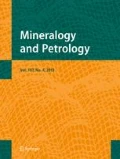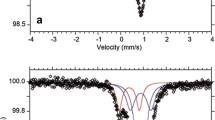Abstract
Orange, ochre-coloured, light green and dark blue varieties of kyanite, ideally Al2SiO5, from Loliondo, Tanzania, have been characterised by electron microprobe analysis and polarised infrared and optical absorption spectroscopy. All colour varieties show elevated Fe contents of 0.39 to 1.31 wt.% FeO, but Ti contents only in the range of the EMP detection limit. Orange and ochre-coloured crystals have Mn contents of 0.23 and 0.06 wt.% MnO, respectively, the dark blue kyanite contains 0.28 wt.% Cr2O3, while the light green sample is nearly free from transition metal cations other than Fe. Polarised infrared spectra reveal OH defect concentrations of 3 to 17 wt.ppm H2O with structural OH defects partially replacing the OB (O2) oxygen atoms. Polarised optical absorption spectra show that the colour of all four varieties is governed by crystal field d-d transitions of trivalent cations, i.e. Fe3+ (all samples), Mn3+ (orange and ochre) and Cr3+ (blue kyanite), replacing Al in sixfold coordinated triclinic sites of the kyanite structure. Intervalence charge transfer, the prevalent colour-inducing mechanism in ‘usual’ (Cr-poor) blue kyanites, seems to play a very minor, if any, role in the present samples. Crystal field calculations in both a ‘classic’ tetragonal and in the semiempirical Superposition Model approach, accompanied by distance- and angle-least-squares refinements, indicate that Fe3+ preferably occupies the Al4 site, Cr3+ prefers the Al1 and Al2 sites, and Mn3+ predominantly enters the Al1 site. In each case specific local relaxation effects were observed according to the crystal chemical preferences of these transition metal cations. Furthermore, the high values obtained in the calculations for the interelectronic repulsion parameter Racah B correspond to a high ionic contribution to Me3+–O bonding in the kyanite structure. In the particular case of the blue sample, band positions specifically related to the high Racah B value enable this ‘unusual’ type of blue colouration of kyanite solely due to Cr3+ cations.






Similar content being viewed by others
References
Abs-Wurmbach I, Langer K (1975) Synthetic Mn3+-kyanite and viridine, (Al2–xMnx 3+)SiO5, in the system Al2O3–MnO–MnO2–SiO2. Contrib Mineral Petrol 49:21–38
Andrut M, Wildner M (2002) The crystal chemistry of birefringent natural uvarovites. Part III. Application of the Superposition Model of crystal fields with a characterization of synthetic uvarovite. Phys Chem Minerals 29:595–608
Andrut M, Wildner M, Rudowicz CZ (2004) Optical absorption spectroscopy in geosciences. Part II: quantitative aspects of crystal fields. In: Beran A, Libowitzky E (eds) Spectroscopic methods in mineralogy. EMU Notes in Mineralogy 6. Eötvös Univ Press, Budapest, pp 145–188
Baerlocher C, Hepp A, Meier WM (1977) DLS-76, a program for the simulation of crystal structures by geometric refinement. Inst. f. Kristallographie und Petrographie, ETH, Zürich
Bell DR, Rossman GR, Maldener J, Endisch D, Rauch F (2004) Hydroxide in kyanite: a quantitative determination of the absolute amount and calibration of the IR spectrum. Am Mineral 89:998–1003
Beran A, Götzinger MA (1987) The quantitative IR spectroscopic determination of structural OH groups in kyanites. Mineral Petrol 36:41–49
Beran A, Langer K, Andrut M (1993) Single crystal infrared spectra in the range of OH fundamentals of paragenetic garnet, omphacite and kyanite in an eclogitic mantle xenolith. Mineral Petrol 48:257–268
Burnham CW (1963) Refinement of the crystal structure of kyanite. Z Kristallogr 118:337–360
Burns RG (1993) Mineralogical applications of crystal field theory, 2nd edn. Cambridge University Press, Cambridge
Burt JB, Ross NL, Gibbs GV, Rossman GR, Rosso KM (2007) Potential protonation sites in the Al2SiO5 polymorphs based on polarized FTIR spectroscopy and properties of the electron density distribution. Phys Chem Miner 34:295–306
Chadwick KM, Rossman GR (2009) Orange kyanite from Tanzania. Gems Gemology 45:146–147
Chang YM, Rudowicz C, Yeung YY (1994) Crystal field analysis of the 3dN ions at low symmetry sites including the “imaginary” terms. Computers Phys 8:583–588
Czaja M, Mazurak Z, Lukowiak E (1995) Spectroscopic properties and crystal-field analysis of Cr3+ ions in kyanite Al2SiO5. J Appl Spectr 62:648–655
Faye GH, Nickel EH (1969) On the origin of colour and pleochroism of kyanite. Can Mineral 10:35–46
Gaft M, Nagli L, Panczer G, Rossman GR, Reisfeld R (2011) Laser-induced time-resolved luminescence of orange kyanite Al2SiO5. Opt Mater 33:1476–1480
Hutton DR, Troup GJ (1964) Paramagnetic resonance of Cr3+ in kyanite. Brit J Appl Phys 15:275–280
Johnson EA (2006) Water in nominally anhydrous crustal minerals: speciation, concentration, and geologic significance. In: Keppler H, Smyth JR (eds) Water in nominally anhydrous minerals. Rev Mineral Geochem 62, Miner Soc Amer, pp 117–154
Kroll H, Maurer H, Stöckelmann D, Beckers W, Fulst J, Krüsemann R, Stutenbäumer T, Zingel A (1992) Simulation of crystal structures by a combined distance-least-squares/valence-rule method. Z Kristallogr 199:49–66
Langer K (1976) Synthetic 3d3+-transition metal bearing kyanites, (Al2-xMx 3+)SiO5. In: Strens RGJ (ed) The physics and chemistry of minerals and rocks. Wiley, New York, pp 389–402
Langer K (1988) UV to NIR spectra of silicate minerals obtained by microscope spectrometry and their use in mineral thermodynamics and kinetics. In: Salje EKH (ed) Physical properties and thermodynamic behaviour of minerals. Reidel Publ, pp 639-685
Langer K, Frentrup KR (1973) Synthesis and some properties of iron- and vanadium-bearing kyanites, (Al,Fe3+)2SiO5 and (A1,V3+)2SiO5. Contrib Mineral Petrol 41:31–46
Langer K, Seifert F (1971) High pressure- high temperature-synthesis and properties of chromium kyanite, (Al,Cr)2SiO5. Z Anorg Allg Chem 383:29–39
Leavitt RP (1982) On the role of certain rotational invariants in crystal field theory. J Chem Phys 77:1661–1663
Lever ABP (1984) Inorganic electronic spectroscopy, 2nd edn. Elsevier, Amsterdam
Libowitzky E, Beran A (2004) IR spectroscopic characterisation of hydrous species in minerals. In: Beran A, Libowitzky E (eds) Spectroscopic methods in mineralogy. EMU Notes in Mineralogy 6. Eötvös Univ Press, Budapest, pp 227–279
Libowitzky E, Rossman GR (1996) Principles of quantitative absorbance measurements in anisotropic crystals. Phys Chem Miner 23:319–327
Newman DJ (1971) Theory of lanthanide crystal fields. Adv Phys 20:197–256
Newman DJ, Ng B (1989) The superposition model of crystal fields. Rep Prog Phys 52:699–763
Newman DJ, Ng B (2000) Crystal field handbook. Cambridge University Press, Cambridge
Norrestam R (1994) The effective shapes and sizes of Cu2+ and Mn3+ ions in oxides and fluorides. Z Kristallogr 209:99–106
Parkin KM, Loeffler BM, Burns RG (1977) Mössbauer spectra of kyanite, aquamarine, and cordierite showing intervalence charge transfer. Phys Chem Miner 1:301–311
Platonov AN, Tarashchan AN, Langer K, Andrut M, Partzsch G, Matsyuk SS (1998) Electronic absorption and luminescence spectroscopic studies of kyanite single crystals: differentiation between excitation of FeTi charge transfer and Cr3+ dd transitions. Phys Chem Miner 25:203–212
Rodríguez-Mendoza UR, Rodríguez VD, Lavín V, Martín IR, Nuñez P (1999) Fano antiresonances of Cr3+ in alkaline disilicate glasses. Spectrochim Acta A55:1319–1322
Rossman GR (2012) Mineral Spectroscopy Server. http://minerals.gps.caltech.edu/. Accessed 17 September 2012
Shannon RD (1976) Revised effective ionic radii and systematic studies of interatomic distances in halides and chalcogenides. Acta Crystallogr A32:751–767
Smith G, Strens RGJ (1976) Intervalence transfer absorption in some silicate, oxide and phosphate minerals. In: Strens RGJ (ed) The physics and chemistry of minerals and rocks. Wiley, New York, pp 583–612
Souza SO, Selvin PC, Watanabe S (2003) Thermally stimulated luminescence, optical absorption and EPR studies on kyanite crystals. J Luminescence 102–103:575–580
Sturge MD, Guggenheim HJ, Pryce MHL (1970) Antiresonance in the optical spectra of transition-metal ions in crystals. Phys Rev B2:2459–2471
Troup GJ, Hutton DR (1964) Paramagnetic resonance of Fe3+ in kyanite. Brit J Appl Phys 15:1493–1499
Uylings PHM, Raassen AJJ, Wyart JF (1984) Energies of N-equivalent electrons expressed in terms of two-electron energies and independent three-electron parameters: a new complete set of orthogonal operators: II. Application of 3d N configurations. J Phys (B) 17:4103–4126
Wieczorek A, Libowitzky E, Beran A (2004) A model for the OH defect incorporation in kyanite based on polarised IR spectroscopic investigations. Schweizer Miner Petrogr Mitt 84:333–343
Wildner M, Andrut M, Rudowicz CZ (2004) Optical absorption spectroscopy in geosciences. Part I: basic concepts of crystal field theory. In: Beran A, Libowitzky E (eds) Spectroscopic methods in mineralogy. EMU Notes in Mineralogy 6. Eötvös Univ Press, Budapest, pp 93–143
Winter JK, Ghose S (1979) Thermal expansion and high-temperature crystal chemistry of the Al2SiO5 polymorphs. Am Mineral 64:573–586
Wojtowicz AJ (1991) Luminescence of Cr3+ in kyanite. J Luminescence 50:221–230
Wojtowicz AJ, Lempicki A (1990) Cr3+ in kyanite: a new mechanism of thermally enhanced 2E decay. J Luminescence 46:271–276
Yang H, Downs RT, Finger LW, Hazen RM, Prewitt CT (1997) Compressibility and crystal structure of kyanite, Al2SiO5, at high pressure. Am Mineral 82:467–474
Yeung YY, Qin J, Chang YM, Rudowicz C (1994a) Correlation of spectroscopic properties and substitutional sites of Cr3+ in aluminosilicates: I. Kyanite. Phys Chem Miner 21:526–531
Yeung YY, Rudowicz C, Chang YM, Qin J (1994b) Model calculation of the spectroscopic properties for Cr3+ in kyanite. J Luminescence 60&61:108–111
Acknowledgments
The authors thank Y.Y. Yeung (Hong Kong) for providing a modified copy of his HCFLDN2 program and H. Kroll (Münster) for a copy of the DVLS program package. The crystal slabs for the spectroscopic investigations were carefully prepared by A. Wagner (Vienna). M. Schrauder (Vienna) kindly provided the kyanite samples from Loliondo, Tanzania, for the present study. Comments by G.R. Rossman (Pasadena) and by an anonymous reviewer helped to improve the manuscript and are highly appreciated. Thanks are also due to guest editor T. Armbruster (Bern) for editorial handling of the manuscript.
Author information
Authors and Affiliations
Corresponding author
Additional information
Editorial handling: G. Giester
Dedicated to the occasion of the 90th birthday of Prof. Josef Zemann
Rights and permissions
About this article
Cite this article
Wildner, M., Beran, A. & Koller, F. Spectroscopic characterisation and crystal field calculations of varicoloured kyanites from Loliondo, Tanzania. Miner Petrol 107, 289–310 (2013). https://doi.org/10.1007/s00710-012-0248-0
Received:
Accepted:
Published:
Issue Date:
DOI: https://doi.org/10.1007/s00710-012-0248-0




